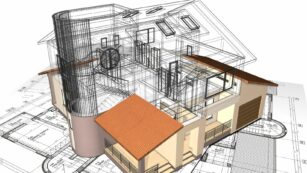Architecture isn’t just about buildings; it’s about pushing boundaries and setting trends. As technology advances and societal needs evolve, architects are stepping up, bringing innovative ideas that redefine how spaces are designed, built, and experienced. From sustainable designs that prioritize environmental health to smart buildings that adapt to their occupants’ needs, the field of architecture is experiencing a renaissance of creativity and purpose.
New Ideas in Architecture
Exploring new ideas in architecture reveals a dynamic field where creativity meets functionality. This section delves into groundbreaking approaches like sustainable design and the integration of new materials and technologies.
Sustainable Design and Green Buildings
 Sustainable design in architecture focuses on minimizing environmental impact while enhancing building functionality and occupant comfort. Green buildings incorporate several key features: energy-efficient systems, use of renewable energy sources like solar and wind, and water-saving plumbing fixtures. For example, buildings such as The Edge in Amsterdam utilize natural lighting and energy generated from onsite solar panels, drastically reducing their reliance on non-renewable energy sources. This approach not only conserves energy but also ensures buildings contribute positively to their environments.
Sustainable design in architecture focuses on minimizing environmental impact while enhancing building functionality and occupant comfort. Green buildings incorporate several key features: energy-efficient systems, use of renewable energy sources like solar and wind, and water-saving plumbing fixtures. For example, buildings such as The Edge in Amsterdam utilize natural lighting and energy generated from onsite solar panels, drastically reducing their reliance on non-renewable energy sources. This approach not only conserves energy but also ensures buildings contribute positively to their environments.
Utilizing New Materials and Technologies
The integration of new materials and technologies in architecture is transforming traditional building practices. Innovative materials such as self-healing concrete, which repairs its own cracks, and transparent aluminum, combining the aesthetics of glass with the strength of metal, are making significant strides. Technological advancements, such as 3D printing and AI-driven design tools, allow for complex, cost-effective construction processes. Buildings like the Striatus Bridge in Venice showcase how 3D printing can be used to create complex, load-bearing structures without metal reinforcement, demonstrating the potential of new technologies to redefine architectural limits.
Innovation in Urban Planning
This section delves into how innovation in urban planning is realizing smarter cities and fostering mixed-use developments.
Smart Cities and Internet of Things (IoT)
 Smart cities leverage the Internet of Things (IoT) to enhance urban functionality and the quality of life for their residents. Through interconnected devices and sensors, cities can manage resources more efficiently, improve traffic flow, monitor environmental conditions, and enhance public safety. For instance, sensors can adjust traffic signals based on real-time traffic data, reducing congestion and pollution. Another example includes IoT-enabled lighting systems that automatically adjust based on natural light availability and occupancy, promoting energy conservation. These smart technologies not only make city living more adaptive and intuitive but also support sustainability efforts by minimizing resource wastage.
Smart cities leverage the Internet of Things (IoT) to enhance urban functionality and the quality of life for their residents. Through interconnected devices and sensors, cities can manage resources more efficiently, improve traffic flow, monitor environmental conditions, and enhance public safety. For instance, sensors can adjust traffic signals based on real-time traffic data, reducing congestion and pollution. Another example includes IoT-enabled lighting systems that automatically adjust based on natural light availability and occupancy, promoting energy conservation. These smart technologies not only make city living more adaptive and intuitive but also support sustainability efforts by minimizing resource wastage.
Mixed-Use Developments
Mixed-use developments combine residential, commercial, and recreational spaces into one compact and integrated layout. These developments are key to creating vibrant neighborhoods where people can live, work, and play in close proximity. By merging various land uses, these areas reduce the need for commuting, thereby decreasing traffic congestion and air pollution. For example, a mixed-use development might house apartments, a grocery store, office spaces, and a park within a single block. This not only facilitates a more active, community-focused lifestyle but also boosts local economies by keeping travel and transactions within a small geographic area, fostering a sense of community among residents. Mixed-use developments align well with sustainable urban planning goals, as they efficiently utilize space and resources.
Architectural Design and Human Experience
Integrating Sensory Elements in Architecture
 Integrating sensory elements into architectural designs enhances the human experience effectively. Buildings not only house activities but also engage the senses. Architects utilize elements like natural lighting, acoustic treatments, and tactile materials to create environments that promote well-being and comfort. Examples of buildings prioritizing sensory experiences include libraries with optimized sound insulation for quiet reading areas and hospitals designed with calming color schemes and natural views to aid recovery.
Integrating sensory elements into architectural designs enhances the human experience effectively. Buildings not only house activities but also engage the senses. Architects utilize elements like natural lighting, acoustic treatments, and tactile materials to create environments that promote well-being and comfort. Examples of buildings prioritizing sensory experiences include libraries with optimized sound insulation for quiet reading areas and hospitals designed with calming color schemes and natural views to aid recovery.
Designing for Emotional Impact
Architecture profoundly influences emotions, and thoughtful designs can evoke a range of feelings from tranquility to awe. Spaces like memorials and museums are particularly focused on emotional architecture, where the design intentionally reflects and elicits emotional responses. The National September 11 Memorial & Museum in New York uses spatial flow, reflective materials, and controlled lighting to cultivate a solemn atmosphere of remembrance and reflection.

